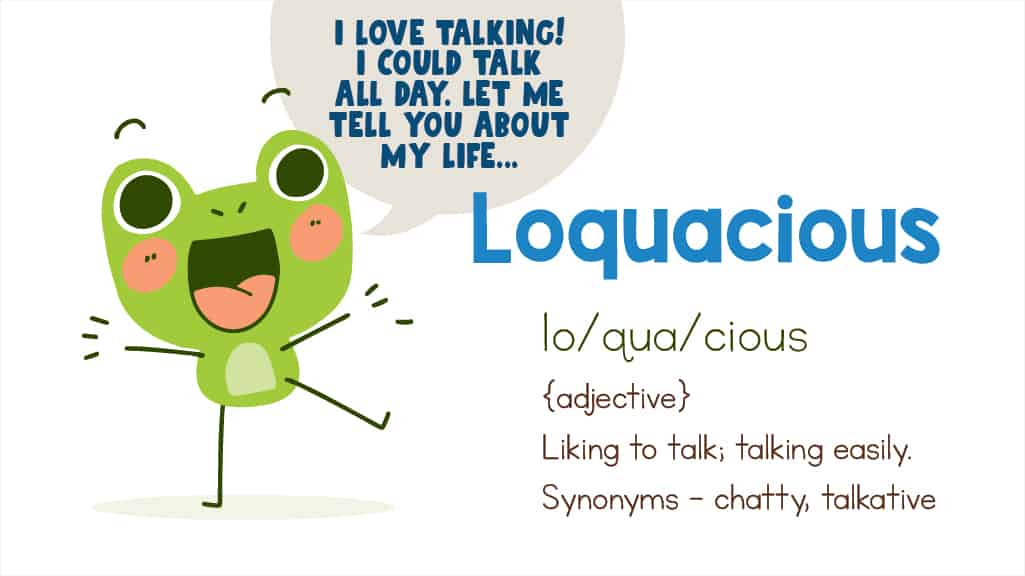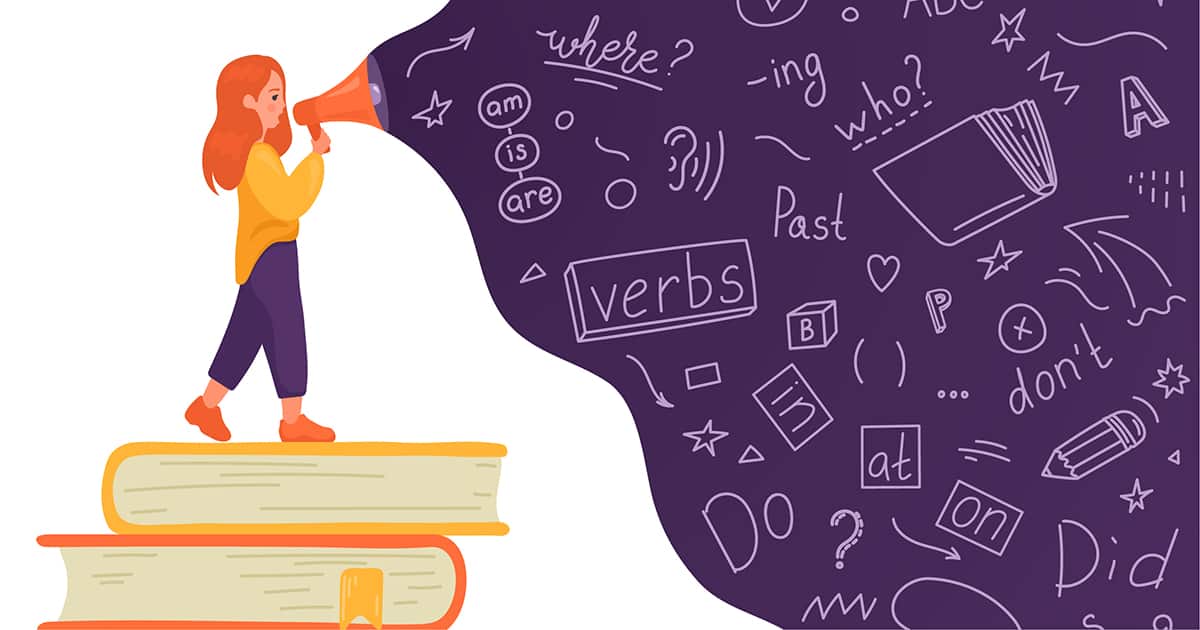The Ultimate 13 Vocabulary Development Activities for Kids
As a Montessori teacher, I’ve seen how vocabulary development activities make learning words fun. It’s awesome to see students using new words in their everyday talk with ease.
To help kids naturally grow their language skills, I’ve tried different strategies to make learning new words exciting. In this article, I’m here to share some effective methods that I think will be helpful for you too.
13 Vocabulary Development Activities for Kids
Tap into the power of Montessori-aligned vocabulary growth! Integrate these vocabulary building examples with your students and witness their understanding of words soar as they engage in meaningful language exploration.
1. Elevate elementary communication with descriptive language.
Have you ever noticed how using interesting words can make conversations more exciting? That’s why I choose to use a vast vocabulary with my students!
Using unfamiliar words in conversation with elementary students is one of the most simple elementary vocabulary development activities that will lead them to ask questions, and consequently, expand their vocabulary in the process.
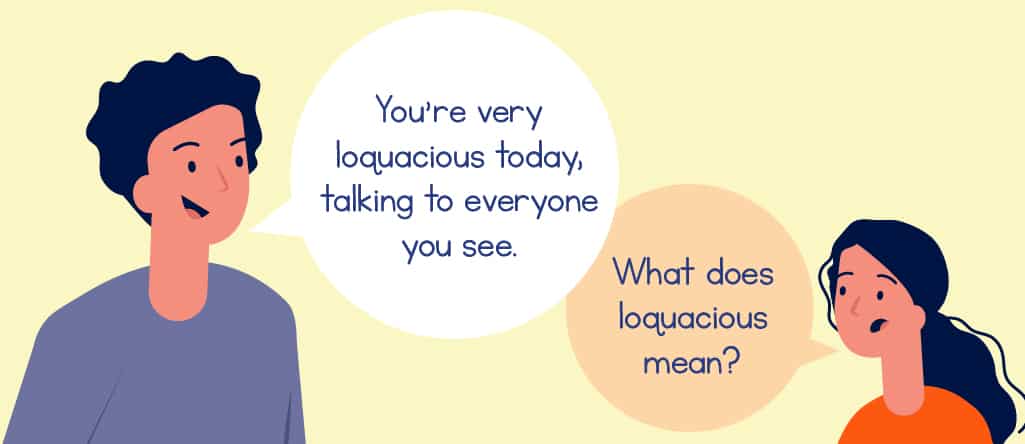
The child in the second plane of development, the 6 to 12-year-old learner, is striving for intellectual independence. They are developing their ability to think abstractly, leading them to want to ask all sorts of questions.
I encourage you to exemplar the importance of words by using intricate and flashy words, like loquacious, with the kids in your life and have fun with the words.
Just be prepared to answer all of their questions about what those words mean, what their functions are and where they can learn more about them. Better yet, have them look the words up themselves in an actual print dictionary.
Ah, the dictionary. This brings us to the next vocabulary development activity.
2. Boost vocabulary with dictionary activities.
Unleash the power of vocabulary development activities for elementary students through the often-overlooked skill of using a print dictionary.
Sure, word meanings can be found and learned online, but flipping through the dictionary with the hands is a whole other experience and connection.

We may all love our eReaders, but I bet that most of us enjoy and connect with the feeling of flipping pages in a physical book. Are you with me?
Dr. Maria Montessori felt strongly that the hand and brain must develop in harmony.
Think of it like the hand reporting to the brain and then the brain guiding the hand. It’s a continuous cycle of development of the intellect.
Unlike finding the definition of a word online, using a print dictionary exercises more than just the child’s mind.
Try these vocabulary development dictionary activities:
✏️ Noun, Verb, Adjective – Cut out 9 squares and label them “noun,” “verb,” and “adjective,” to represent different parts of speech. Shuffle the squares and place them face down. Open the dictionary to a random page and pick a square to see which part of speech to search for. Make a list of all the words on that random page that match the revealed part of speech.
✏️ Define It! – One person holds the dictionary and selects a challenger. The challenger calls out a page number, then calls out ‘left’ or ‘right’ for the columns on the page, and then a number from 1-10 for word position. The dictionary holder reads out that word from the dictionary and the challenger has to define the word to the best of their ability. Compare their definition with the dictionary’s definition for points.
✏️ Words, Words, Words – Each player will need paper and a pencil! Each player picks one word from the dictionary, writes the word on a piece of paper, and places it in the middle of the table, piled with the words of other players. Starting with the word on top of the pile, each player writes a sentence using the word, even if they don’t know what it means. Players read sentences aloud and vote for the one they believe is correct. After voting is complete, the true definition is presented.
In addition to learning definitions, children also practice finding words in alphabetical order which exercises their ability to sequence, spell, and problem-solve.
And it teaches them patience! In a world so filled with instant gratification, using a print dictionary slows the learner down allowing them to engage with the process of research while absorbing the information.
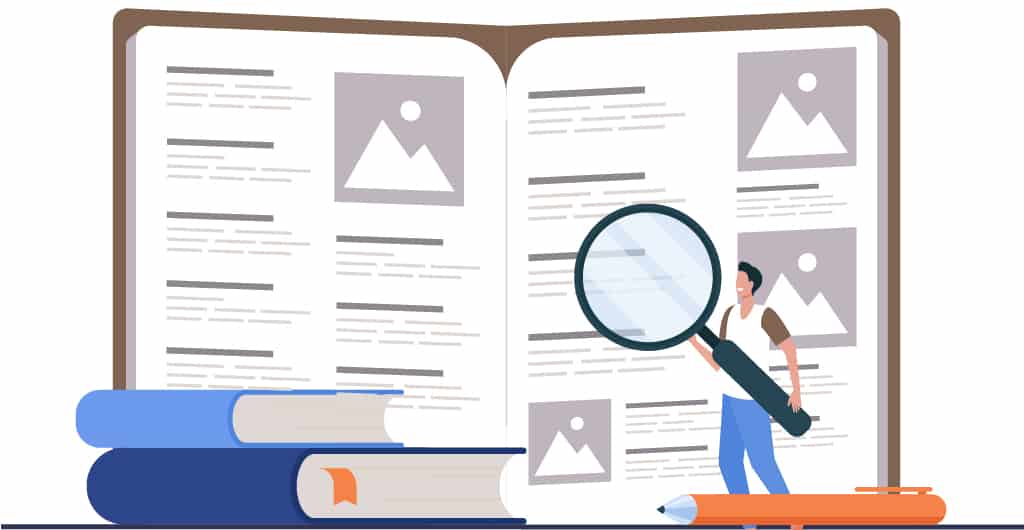
A dictionary isn’t just full of word definitions, it is full of learning in disguise and teachable moments.
So give elementary-level learners a brain workout by having them develop their vocabulary using a paperback or hardcover dictionary.
Don’t have a physical dictionary in your classroom? Get one now!
We suggest Merriam-Webster’s Elementary Dictionary. This dictionary features 35,000 words and phrases along with some illustrations.
✏️ BONUS Activity: Word Detectives vocabulary development game.
Try this activity with your elementary students! Have players open the dictionary to a random page, choose an unfamiliar word, and challenge them to use it at least five times during the week in class or in their writing.
Enjoy the fun of expanding language skills together!
3. Expand elementary vocabulary through reading all sorts of things.
Together, in small groups, independently, out loud, silently – however, it is done, all types of reading will expose learners to words that are not commonly used in their everyday conversations.
Known as reading widely, sharing many different kinds of reading material with elementary students is a great vocabulary development activity that puts kids face-to-face with unfamiliar words and phrases.
These words will be learned and the information accrued about them stowed away in the brain to use later on.

So integrate reading materials like comic books, graphic novels, fiction, non-fiction, poems, newspaper articles, picture books, magazines, and blogs into your teaching toolkit!
By providing reading material tailored to the interests of 6 to 12-year-olds, they’re more likely to absorb new words and knowledge.
As an upper elementary teacher in a Montessori classroom, I have chatted with many concerned parents regarding their child’s desire to solely read Captain Underpants.
My take on Captain Underpants, and the literature equivalent to it is simply this – if it gets them reading, don’t interfere.
Even with quirky humour and some misspelled words, graphic novels attract many readers. These books encourage some students to dive into reading, and that’s fantastic!
Here are 7 books that captivated my reluctant readers:
✨ Highlights Magazine
✨ Mr. Wolf’s Class
✨ The Guinness Book of World Records 2024
✨ National Geographic Kids Almanac 2024
✨ The Who Was series
✨ Game On!
✨ Laugh Out Loud Jokes for Kids
Reading a variety of texts also provides an opportunity for students to make new discoveries.
Poetry might inspire them to write a few lines or even their own song. Reading comics might unlock a love of drawing or storytelling. Magazines might lead a student to want to design. You just never know.
Explore a world of reading adventures with our blog 31 Fun Summer Reading Activities Elementary Students Will Love for more exciting reading activities for kids!
I’m always looking for ways to spark my student’s interest in something they didn’t even know they had an interest in. Exploring the world around them through reading materials opens up a creative world inside them.
If you’re looking to step outside of the box and get students interested in more types of reading materials, then start introducing multiple styles of reading texts with students to help them discover what they love to read.
📓 We created an engaging activity book for elementary students!
Our activity book is so fun kids don’t even realize that they are picking up important language skills and absorbing new vocabulary words as they read over 10 drawing prompts for kids and flex their creative muscles.
Read more about why your kids need this activity book with intriguing drawing prompts! It’s learning made enjoyable!
Reminder: Reading should never feel like a chore or punishment. Encourage them to follow their interests, make their own choices, and witness their natural love for reading blossom!
4. Expand vocabulary development through contextual teaching.
Explore an effective approach to expanding vocabulary development with contextual teaching. In this method, words are introduced and understood within specific contexts, making the learning process more engaging and memorable for students.
Here’s my approach:
When crafting lessons, I intentionally introduce a few advanced words, fostering curiosity. Students are faced with a list of unfamiliar words, allowing me to teach them the valuable skill of using context clues to deduce meanings.
Context clues involve recognizing familiar words in a text surrounding the unknown word, aiding students in deciphering its meaning.
For example, consider the sentence: “Dewey likes to dress ostentatiously. He’s never seen wearing a dull outfit.”
Chances are the word ‘ostentatiously’ is unfamiliar. However, by leveraging context clues from the surrounding words, we can make an educated guess that it likely means not dull, possibly even showy.
This method seamlessly integrates vocabulary development into everyday learning experiences.

Teaching vocabulary in context is a strategy that invites students to think about the words they are reading. Students learn by seeing how words are used in sentences.
✨ Teacher Tip: How to implement this strategy.
Encourage students to craft their own definitions for unfamiliar words, either in a notebook or on the computer, as they build their personalized word journals with the words they’re learning.
Take it a step further by having elementary learners build sentences that incorporate these words correctly.
To enhance the learning experience even further, ask them to include illustrations, fostering a powerful connection between hand and brain.
5. Word games are great vocabulary development activities.
I love word games. In the classroom or at home, I’m always up for a game that involves words. And when I introduce a word game to my elementary students with enthusiasm I spread that love of learning through word games.
When learning is fun students absorb more information than they usually would.
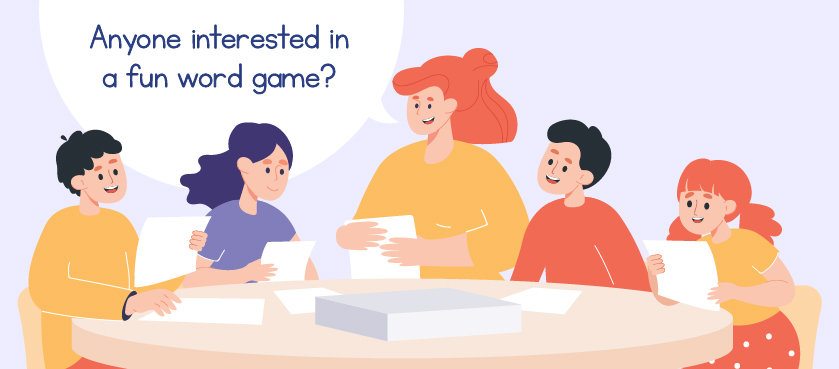
That’s why it’s beneficial to use fun vocabulary development activities for elementary students that introduce them to a vast vocabulary.
Using word games in the classroom tones down the seriousness of the learning process, even though learning is still actively taking place. We call this learning in disguise or stealth learning.
🧩 Have you introduced your elementary learners to rebus puzzles yet?
Not sure what Rebus puzzles are? It’s the perfect word card game!
Rebus puzzles provide an entertaining and educational challenge for kids. They help students develop problem-solving skills and improve their critical thinking abilities.
Keep reading to learn more about rebus puzzles and how they are great vocabulary development activities.
🧐 Check out some easy rebus puzzles here and see if you can solve them!
Infuse your language curriculum with more joyful learning by incorporating vocabulary games. As learners relax and have fun, they effortlessly retain new words and information, fostering a dynamic language development experience.
Here are some of my favourite word games for kids!
✨ Try the kid-friendly Wordle with your elementary-aged learners. In addition to honing spelling knowledge, this online game teaches problem-solving skills and logical thinking.
✨ What about Scattergories The Card Game? A kid-friendly, portable card game that gets students practicing vocabulary and quick thinking. Great for the elementary-aged student, this fast-paced game of matching words to categories is a fun challenge.
✨ You should also try Scattergories Categories. While this game states the age range is 12+, I have used it with upper elementary students. This game starts with categories first which sounds and is complicated but it’s hours of educational entertainment, so it’s worth working through the learning curve!
✨ And of course, there’s the classic Scrabble. Students develop an extensive vocabulary and become proficient in spelling by using this game as an enrichment activity in the classroom. Have you tried Scrabble Slam? Learners work quickly, and all at the same time, to build four-letter words. A game where ‘fate’ can turn to ‘fame’. Ha!
✨ One of my go-to word activities with my upper elementary students is Bananagrams. Like Scrabble, but with no board, in this game, lowercase letter tiles are used as manipulatives to build words. Spelling is relevant here so learners should be equipped with a dictionary!
Check out the printed book version of this game called Bananagrams For Kids. This book offers children a wide variety of word-making activities. And there’s also Bananagrams Duel, a two-player game where players use letter cubes to build their word grid!
Add friendly competition through word games to your language lessons to keep the elementary child interested in playing and learning more.
6. Word of the week for improving elementary vocabulary.
My students, whether in person or online, always enjoyed learning the ‘word of the week.’ It brought a fun element to our lessons and kept them excited about discovering new words.
I tend to choose funny-sounding words, words with irregular spelling, and words with weird meanings to hold their attention.
Words I know they can understand and therefore use in their sentences, but words that stick out and would keep them interested in what other words are out there to learn.
Offering students a ‘word of the week’ is an easy vocabulary development activity to add to any elementary classroom. Introduce a new word every Monday morning and have students add it to their notebooks.
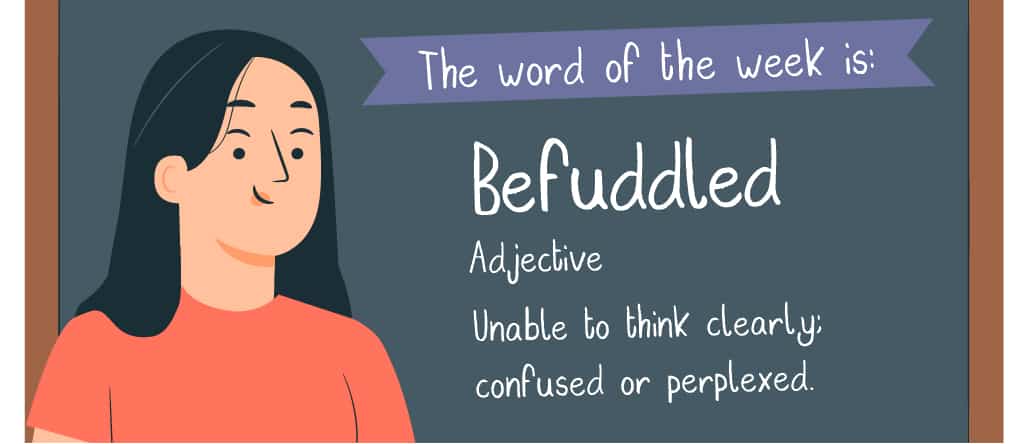
Have them look up the definition of the new word, identify its part of speech, find synonyms, illustrate it, and clap out the syllables. The goal is to have them create connections with these words and use them in sentences throughout the week.
💡 Teacher Tip: Bring excitement to your language lessons with videos!
By using the engaging videos featured in our blog, Parts of Speech Videos for Your Elementary Language Lessons you’ll be able to entertain and educate your students about the different parts of speech.
Use words that can be implemented in conversation, that are intriguing, and that allow students to feel pretty smart when they use them.
Hey, you can even let students take turns choosing the word of the week. You’re guaranteed to get some riveting word selections.
If implemented every week for the entire school year, students will learn about 40 new words. Talk about enhancing their word knowledge!
💡 Use our ‘Word of the Week’ vocabulary activities with your students!
Designed to develop vocabulary at the elementary level while having fun, these digital downloads were such a hit with my students that we had to turn them into a product for others to enjoy.
In both of our Word of the Week products, you’ll find 16 weeks’ worth of advanced words to study. This Google Slides document includes a different word on each slide with its definition, syllable breakdown, part of speech, as well as synonyms for the word. So much learning!
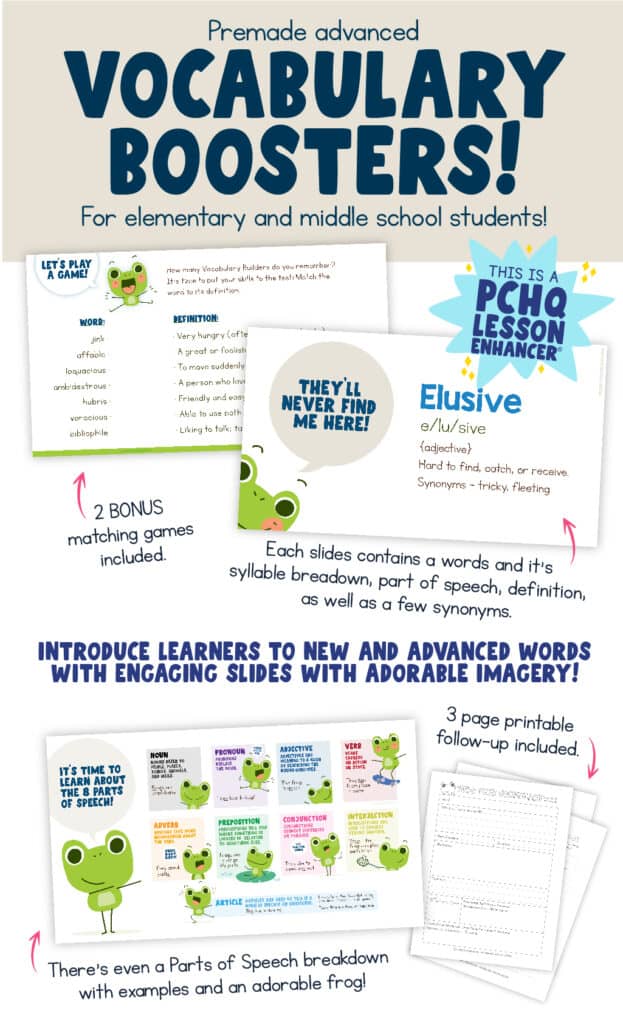
There are even example sentences provided to further expand their understanding of each word. Equipped with a graphic organizer, this lesson enhancer is great for building vocabulary at the elementary level.
🐸 🐸 🐸
Check out and download our free sample pack!
This FREE DOWNLOAD is a sample of our Vocabulary Booster and includes a word slide, printable parts of speech poster, and a graphic organizer for learning and recording new words.
BONUS – the free sample pack also comes with printables and some math activities. It’s worth a click!
7. Develop student vocabulary through root words and affix activities.
I enjoy teaching lessons on root words and affixes because they often lead to a light bulb moment for some students – an instance when a learner’s eyes light up with sudden understanding.
Exploring roots and affixes changes the way you perceive words in the world around you. Recognizing that complex words are often combinations of smaller ones offers valuable insight. This is why studying roots and affixes is crucial.
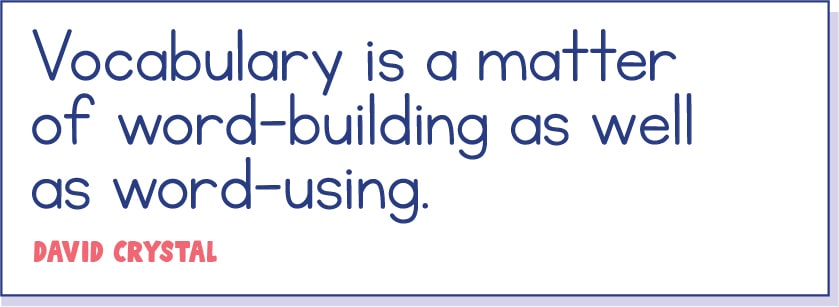
Knowing roots and affixes can help students understand new words. When elementary learners grasp these language building blocks, it becomes easier for them to analyze unfamiliar vocabulary and figure out what it means.
Here’s a simple root word lesson script I use with upper elementary students:
‘A root word is the most basic form of a word.
If you are aware of root words then you’ll be able to break down words into their smaller meanings. Learning just one root can help you understand several other words.
For example, the root “micro” has Greek origins and means small. With this information, we can conclude that the words “microscope”, “microcosm”, “microbe”, and “micronutrient” all have something to do with being small.’
On another day I’ll introduce affixes with a lesson script that starts like this:
‘Affixes, made up of prefixes and suffixes, are added to root words to change their meaning.
Understanding and knowing affixes will help you figure out the meanings of unfamiliar words. It’s like you’re becoming a word detective when you look at affixes.
Prefixes come at the beginning of a word to change its meaning.
Funny enough, prefix has the prefix “pre-” at the beginning. The prefixes dis-, in-, re-, and un- are the most common in the English language. You should probably become familiar with their negative connotations.
Suffixes are found at the end of root words. Interestingly, the word suffix has “-fix” at the end which is a Latin suffix that means to fasten.
Many suffixes are verb endings that change the meaning of a word. The suffixes -ing, -ed, and -es are quite familiar to the elementary student. Other common suffixes are -able, -less, and -ful.’
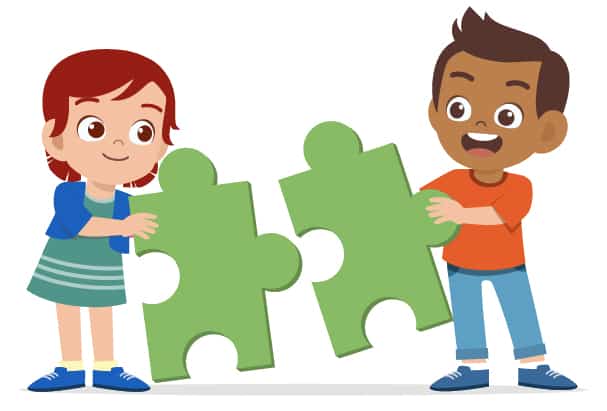
Understanding root words and affixes leads to overall word comprehension.
Even without knowing a word definition, it is possible to understand new terms when affixes and root words are taught at the elementary level. A valuable vocabulary skill to have.
For example, let’s say a student meets the word “inaudible” in a text and they are not sure what it means. Sure, they can look it up in the dictionary, but they can also use their knowledge to break it down.
Knowing that the root “aud” means /to hear/ and the prefix “in” means /not/ is very helpful in figuring out what inaudible means.
They can conclude that the word inaudible means unable to be heard. Brilliant!
🎉 How to Play The Prefix Party 📚
One of my favourite vocabulary activities for practicing roots and affixes with elementary students is what I like to call The Prefix Party. Here’s how to play:
Team up! Form small teams and assign a unique prefix to each group.
Know your prefix. Ensure each team understands their designated prefix before moving forward with the word exploration.
Group brainstorming. Work together to brainstorm and list words starting with the assigned prefix. Team collaboration makes the activity engaging and encourages teamwork.
Guest list concept. Picture each word as an energetic guest attending the prefix party. The objective? Compile the longest list of words with the given prefix.
Word gathering challenge. Challenge teams to accumulate the most ‘guests’ (words) at their prefix party. The goal is to have a diverse and extensive list.
🎈 Let the word celebration begin!
8. Explore words and creativity with a word collage.
Introduce a fun vocabulary development activity to your elementary students with a word collage creation.
Give each student magazines or printed materials and let them cut out interesting words. Have them pick a theme, like emotions or favourite activities, and use glue and markers to create collages on large paper.
This not only expands their vocabulary but also lets them be creative. After finishing, students can share their collages, sparking discussions about their word choices.
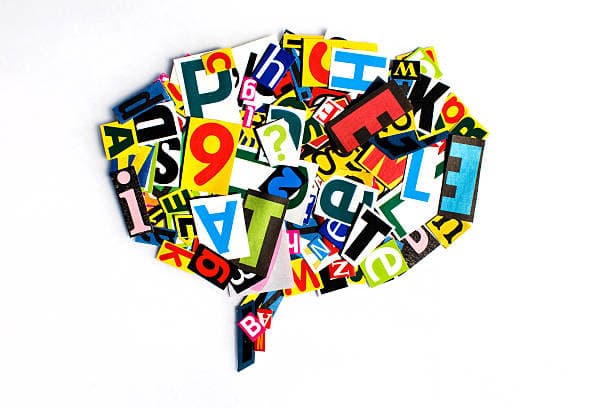
Beyond being creative, the word collage vocabulary activity helps kids use new words in real situations. By visually arranging and displaying their chosen words, students not only learn but also remember and apply these words in everyday conversations and writing.
It’s a Montessori-aligned, hands-on way to make vocabulary learning engaging for elementary learners.
9. Boost vocabulary with picture books featuring rich language.
I firmly advocate for the use of picture books in any classroom, including upper elementary settings, as a powerful learning tool.
Picture books simplify complex topics, demonstrate the meaningfulness of words, and cover diverse subjects – from money books for kids to cultural understanding and exploring emotions, they aid in learning unfamiliar words.
Despite the common preference for chapter books and textbooks, picture books have a significant impact on older students. They captivate kids, offer enjoyable reading experiences, and can even boost vocabulary.
In my pursuit of picture books that expand elementary vocabularies, I sought engaging stories that fostered a love of reading through captivating words and illustrations. While I discovered some excellent reads, I eventually decided to create my own picture book, and with the help and talents of my partner we brought it to life.
Find out more about Carl the Cantankerous Cat, our self-published picture book below!
Giving elementary students picture books with advanced vocabulary creates continuous opportunities for teachable moments, aligning perfectly with Montessori principles.
🤩 Boost vocabulary with fun!
Try these activities after reading picture books with your students.
Explore our list for classroom fun!
In the second phase of development for 6-12-year-olds, their curious minds seek to understand more, and they are naturally drawn to discover meanings while being captivated by the illustrations.
Look for picture books with above-grade words and challenge your elementary-level learners to broaden their vocabulary.
Discover rich vocabulary in Carl the Cantankerous Cat!
Explore over 70 sophisticated words and their meanings in a user-friendly glossary at the back of the book.
Learning new words is a joyful experience for children with Carl!
💡 Exciting News!
Explore the digital edition of our educational picture book, now paired with printable activity pages for enhanced learning experiences!
See more by clicking here!
10. Form word connections with synonyms.
A synonym is a word with the same or nearly the same meaning as another. Associating a new vocabulary word with it’s synonyms is a great way to form lasting connections with the word.
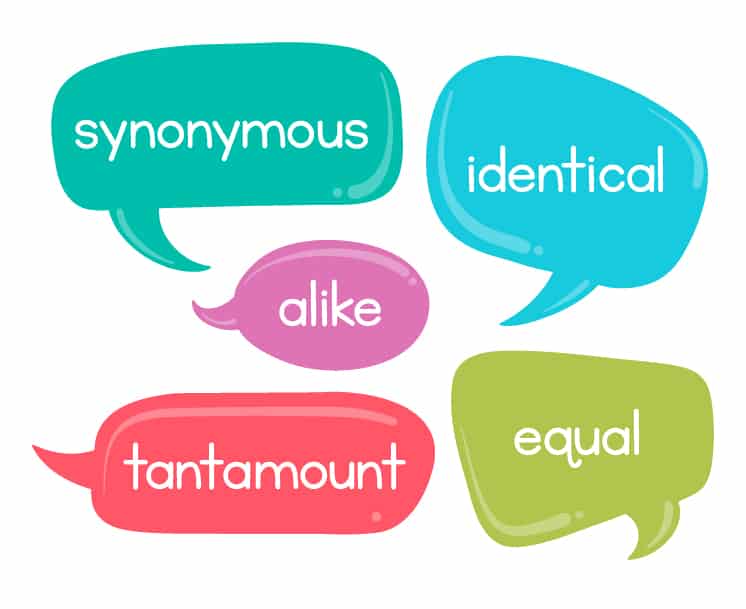
Synonyms offer students a variety of words to express themselves accurately. It makes them think of different ways to say the same thing.
Are your students feeling happy? Why not guide them to express this joyous feeling more precisely using words such as content, gleeful, or even jovial.
A good vocabulary activity for elementary students to increase the number of words they know is to use a thesaurus. A thesaurus is a book of words and their synonyms.
We like DK’s Children’s Illustrated Thesaurus in hardcover. It was created specifically for the elementary child.
Learning synonyms is a great way for elementary students to build their vocabulary which will, in turn, provide them with a variety of words to communicate effectively.
😺 Don’t Miss Out! 🐾
SUBSCRIBE NOW for a FREE cat emoji synonym follow-up activity!
Boost vocabulary development in 1st through 6th graders with our PURRfectly fun cat emotion emojis.
Get your students MEOWtivated and excited about exploring new words. Subscribe today for this vocabulary development activity to be delivered right to your inbox!
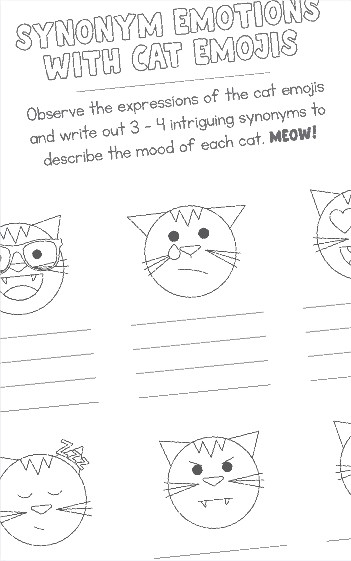
Subscribe to our email list for a firsthand look at engaging learning! Receive Montessori-aligned insights, personal classroom experiences, product recommendations, and our expertise in all things elementary. Stay informed by subscribing now!
11. Use word flash cards as a vocabulary development activity.
Flash cards have information on them, usually on both sides. Often used in math to practice the basic operations, they can be implemented in the language curriculum to build vocabulary.
Encourage your elementary-aged students to make their own vocabulary flashcards.
They can write a new word on one side of a 3-by-5 index card, or even cut out some cards. On the other side, they can write the definition in their own words, the part of speech, and maybe even represent the word with a drawing.
Not up to the task of making flashcards? I get it, no problem! You can find pre-made vocabulary flashcards and just as effective for building elementary-level vocabulary.
The great thing about flashcards is that they are portable, easy to add to, and packed with helpful information. A great activity for vocabulary development.
12. Rebus puzzles are fun vocabulary development activities.
Engaging in vocabulary development through rebus puzzles introduces an exciting twist to learning words.
These visual brain teasers are an absolute delight, encouraging children to think differently about language. By deciphering a combination of images and letters, kids are prompted to explore word meanings, synonyms, sounds, and their relationship with other words.
Check out our blog Rebus Puzzles for Kids: A Comprehensive Riddle-Solving Guide for a deeper look into the world of rebus puzzles, offering some playful riddles for you to solve. They’re not just entertaining; rebus puzzles are a fantastic way to expand vocabulary while keeping the fun quotient high!
🧩 Looking for rebus puzzles for your students? You want these!
Our rebus puzzle products are not only visually pleasing, but they also challenge young minds, encouraging them to interpret visual cues and think critically about word associations.
Rebus puzzles aren’t just about finding solutions; they’re about sparking curiosity, promoting wordplay, and making vocabulary development an entertaining journey. They’re an excellent resource, encouraging kids to explore language in a non-traditional way.
13. Build vocabulary for elementary students through scavenger hunts.
Engaging in scavenger hunts isn’t just about the thrill of the search – it’s a fantastic avenue for vocabulary development! This vocabulary development activity is an interactive way for children to expand their word repertoire while having a blast.
Scavenger hunts offer a dynamic approach to vocabulary development by strengthening the visual connections between words and the world around us.
🔎 Want to know more about scavenger hunts?
💡 Read about the best neighbourhood scavenger hunt here!
💡 Learn how to make a scavenger hunt for kids here!
💡 Expand on the parts of speech with our Parts of Speech Scavenger Hunt!
💡Use our scavenger hunt products to actively engage kids in word discovery.
By immersing elementary students in playful search-and-find activities, they not only expand their vocabulary but also enhance their observational and cognitive skills.
Why Learning New Words is Important
Some words are short, others are long. Some are easy to pronounce, while many words neglect the rules altogether. Like, why is there a ‘g’ in lasagna anyway?
There are even words that sound the same as other words but have different meanings.
Take the words ‘leak’ and ‘leek’ for example. You can have a leak and leeks in your boat, though I’m not sure you’d enjoy either.

And then there are those words that are just really funny to utter out loud. Loquacious for example. Isn’t that a fun word to say?!!? But what does it mean?
🔡 Read to the end to find out what loquacious means!
Those unfamiliar words are usually the ones that elementary students remember. They pique their interest and lead them to want to know more.
Communication is Enhanced with Vocabulary Activities
Vocabulary development activities are crucial for elementary students, but you might wonder why expanding their word bank matters.
Consider the pivotal role vocabulary plays in communication. Our vocabulary, comprising words we recognize and know how to use, serves as the vehicle for expressing needs, wants, and desires. Every aspect of communication – listening, speaking, reading, and writing – involves the utilization of words.
Words, once spoken, carry weight; they are challenging to retract. Whether conveying positivity or negativity, words hold meaning and evoke feelings in others.
Understanding this connection underscores the significance of enriching elementary students’ vocabulary for effective and thoughtful communication.
🧐 Use these vocabulary development activities year-round!
Great for use during the school year but also perfect for the summer to help prevent the summer brain drain!
Teaching students to be precise with their vocabulary will ensure they can be better understood. Additionally, students experience a boost in confidence when using new and advanced words. It gives them a sense of pride.
Funny Story from the Classroom
I taught my upper elementary students the word ‘churn’ during a lesson about the Middle Ages and how they made butter. To my surprise, the word ‘churn’ hit a chord with the entire class. It quickly became a thing.
In gym class, students would ‘churn’ their hips to warm up for sports, at recess they created ‘churn tag’ along with other ‘churn’ related games, the word ‘churn’ made it into many creative writing entries, and somehow ‘churn’ also made it into a math division lesson with the racks and tubes.
What I’m trying to get at here is that introducing the word ‘churn’ (verb – To agitate or cause to move about vigorously.) to my students in this one lesson opened up an epic exploration of how this word can be used all over the curriculum.
My students felt smart, savvy, and even proud when they used this newly acquired word correctly in communication with others.
Since words hold such power, it is important to encourage young minds to absorb all sorts of new ones. That’s why you need to include some of these vocabulary development activities in your elementary classroom routine.
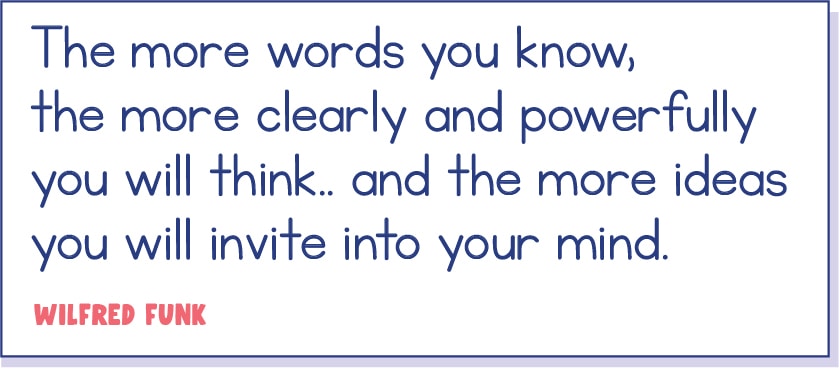
As the writer Wilfred Funk so eloquently noted, the more new words you take in and understand how to use, the more equipped you are to express yourself clearly and the more open your mind is to new ideas.
Research on Vocabulary Development for Kids
When a student realizes how enjoyable using a new word is, there is no limit to where they will implement it.
Take the word ‘churn’ for instance. That word managed to make it into every subject area for months on end. Those students will forever remember that word and be able to use it accurately.
Interestingly yet not surprising, research shows that the words a young child uses are related to later school success. The greater the number of words a child has, the more they can interpret ideas from others and express their ideas precisely.
Studies also outline that a vast vocabulary is directly related to school achievement. It allows children to understand and therefore enjoy what they read and hear. Not only that, but research indicates that building a big vocabulary leads to elementary learners thinking critically about the world around them.
Best of all, it has been documented that developing a rich vocabulary helps elementary students gain confidence. This is mainly because they can express themselves and their thoughts accurately.
Educators are delighted when students connect words, remember them, and then use them later on.
One of my online, homeschooled, Montessori elementary students (that’s a lot of adjectives!) has quite the advanced vocabulary, like really advanced.
He would use words that I would need to look up to make sure I knew what he was talking about.
To give you an example, he used the word ‘mercurial’ to express his unpredictable changes in mood. I dig it, but first I had to dig into the dictionary to find that word’s meaning!
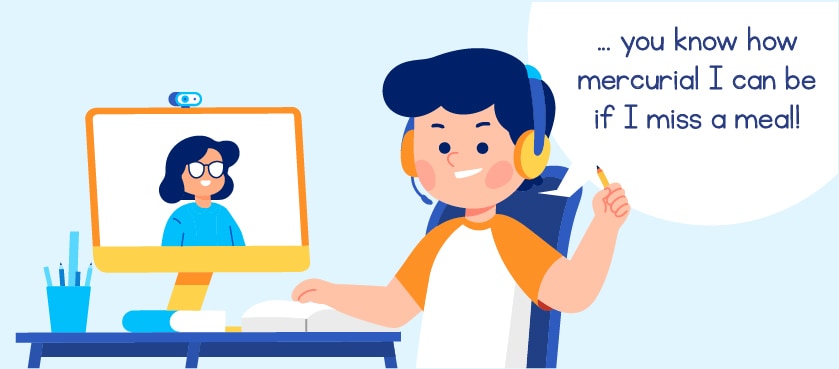
At nine, he is a confident and thoughtful communicator largely due to his understanding of a wide range of words.
Providing vocabulary development activities will help students be more successful academically and communicatively. Awesome!
The Wrap-Up: Vocabulary Development Activities for Elementary Kids
Make a conscious effort to develop vocabulary at the elementary level and prepare our youth to communicate effectively forever, but make it fun!
With practice, these unique vocabulary development activities will add advanced words to your elementary-aged students’ lexicon. Come to think of it, they are even beneficial and interesting for middle school students too.
So whether your students are exploring new vocabulary words together as a class, practicing their SSAT verbal skills independently, or indulging in their genuine interest in words, they can all benefit from these supplemental, easy-to-implement vocabulary development activities.
Do you have any loquacious learners in your classroom?
